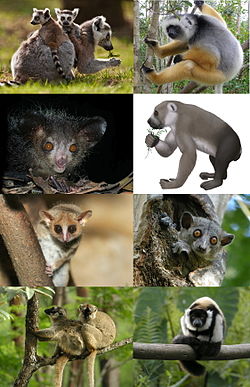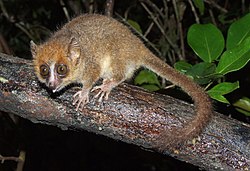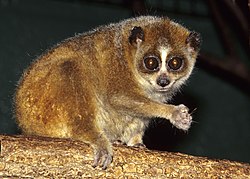Subfossil lemurs are lemurs from Madagascar that are represented by recent (subfossil) remains dating from nearly 26,000 years ago to approximately 560 years...
88 KB (9,962 words) - 10:56, 7 February 2025
Lemurs. pp. 1242–1247. Godfrey, L.R.; Jungers, W.L. (2003). Subfossil Lemurs. pp. 1247–1252. Fietz, J. (2003). Primates: Cheirogaleus, Dwarf Lemurs or...
175 KB (18,681 words) - 06:25, 3 April 2025
of lemur existed on Madagascar. Now represented only by recent or subfossil remains, they were modern forms and are counted as part of the rich lemur diversity...
57 KB (6,396 words) - 07:52, 28 April 2025
Archaeoindris (category Subfossil lemurs)
Archaeoindris was a type of sloth lemur (family Palaeopropithecidae), a recently extinct family of giant lemurs (known as subfossil lemurs) native to Madagascar....
32 KB (3,395 words) - 19:37, 2 April 2025
Lemuridae (category Lemurs)
from the Subfossil records show that many of the now extinct lemurs actually lived in much drier climates than the currently extant lemurs. Groves, C...
11 KB (1,348 words) - 09:36, 18 December 2024
relatively rare lemur, based on a lower number of subfossils recorded. Similar to the sloth lemur, Hadropithecus was a large, slow, specialized lemur, that grazed...
14 KB (1,495 words) - 07:15, 28 April 2025
recently extinct subfossil lemurs. Each agreed that the book was an excellent resource for a wide audience, including ecotourists and lemur researchers. A...
35 KB (3,614 words) - 04:15, 7 May 2025
ring-tailed lemur (Lemur catta) is a medium- to larger-sized strepsirrhine (wet-nosed) primate and the most internationally recognized lemur species, owing...
82 KB (8,895 words) - 00:27, 14 May 2025
The bamboo lemurs or gentle lemurs are the lemurs in genus Hapalemur. These medium-sized primates live exclusively on Madagascar. Bamboo lemurs were first...
8 KB (899 words) - 13:59, 21 March 2025
True lemurs, also known as brown lemurs, are the lemurs in genus Eulemur. They are medium-sized primates that live exclusively on Madagascar. The fur of...
6 KB (527 words) - 03:07, 30 November 2023
Aye-aye (redirect from Aye aye lemur)
The aye-aye (Daubentonia madagascariensis) is a long-fingered lemur, a strepsirrhine primate native to Madagascar with rodent-like teeth that perpetually...
34 KB (3,571 words) - 16:30, 22 April 2025
List of lemuroids (redirect from Lemurs of Madagascar)
200 kg (22 to 441 lb). The largest known subfossil lemur was Archaeoindris fontoynonti, a giant sloth lemur, which weighed more than a modern female gorilla...
170 KB (7,632 words) - 01:26, 28 April 2025
Sifaka (redirect from Sifaka lemur)
A sifaka (/sɪˈfɑːkə/; Malagasy pronunciation: [ˈsifakə̥] ) is a lemur of the genus Propithecus from the family Indriidae within the order Primates. The...
11 KB (1,008 words) - 15:12, 16 January 2025
giant mouse lemurs are members of the strepsirrhine primate genus Mirza. Two species have been formally described; the northern giant mouse lemur (Mirza zaza)...
48 KB (5,373 words) - 20:02, 17 February 2025
KL; Teaford, MF; Jungers, WL (November 2002). "Molar microwear of subfossil lemurs: improving the resolution of dietary inferences". J. Hum. Evol. 43...
13 KB (1,135 words) - 10:32, 7 February 2025
The sportive lemurs are the medium-sized primates that make up the family Lepilemuridae. The family consists of only one extant genus, Lepilemur. They...
11 KB (979 words) - 01:35, 17 December 2024
subspecies. Currently living lemur species are divided into five families and 15 genera. If the extinct subfossil lemurs are included, three families...
74 KB (7,072 words) - 05:01, 5 March 2025
The mouse lemurs are nocturnal lemurs of the genus Microcebus. Like all lemurs, mouse lemurs are native to Madagascar. Mouse lemurs have a combined head...
16 KB (1,510 words) - 01:27, 17 December 2024
subcincta, although studies have not been entirely conclusive. Subfossil remains of two extinct lemur species were previously classified under the genus Varecia...
69 KB (7,664 words) - 07:52, 28 April 2025
Pachylemur (category Subfossil lemurs)
small branches below them. Like other lemurs, Pachylemur was only found on the island of Madagascar, and its subfossil remains have been found primarily at...
34 KB (3,594 words) - 09:48, 7 February 2025
Archaeolemur (category Subfossil lemurs)
genus of subfossil lemurs known from the Quaternary of Madagascar. Archaeolemur is one of the most common and well-known of the extinct giant lemurs as hundreds...
17 KB (1,874 words) - 16:58, 20 February 2025
Hadropithecus (category Subfossil lemurs)
Madagascar. It is known only from subfossil or recent remains and is considered to be a modern form of Malagasy lemur. It died out around 444–772 CE, shortly...
18 KB (1,710 words) - 00:24, 7 February 2025
Babakotia (category Subfossil lemurs)
the infraorder Lemuriformes, which includes all the Malagasy lemurs. The first subfossil remains of Babakotia radofilai were discovered as part of a series...
24 KB (2,268 words) - 11:04, 28 April 2025
Palaeopropithecus (redirect from Large Sloth Lemur)
Palaeopropithecus is a recently extinct genus of large sloth lemurs from Madagascar related to living lemur species found there today. Three species are known,...
18 KB (2,078 words) - 00:56, 15 March 2025
Ampasambazimba (category Subfossil lemurs)
peak and subfossil site in Madagascar, near Analavory, (Itasy) most known for being the site of the remains of the extinct giant sloth lemur Archaeoindris...
8 KB (760 words) - 10:57, 2 July 2024
The woolly lemurs, also known as avahis or woolly indris, are nine species of strepsirrhine primates in the genus Avahi. Like all other lemurs, they live...
9 KB (932 words) - 05:28, 5 February 2025
greater bamboo lemur (Hapalemur simus), also known as the broad-nosed bamboo lemur and the broad-nosed gentle lemur, is a species of lemur endemic to the...
13 KB (1,376 words) - 13:28, 22 October 2024
Giant aye-aye (category Subfossil lemurs)
from subfossil remains. As of 2004[update], giant aye-aye remains consisted of 4 incisors, a tibia, and other postcranial material. Subfossils of this...
2 KB (243 words) - 22:18, 23 March 2025
2 kg, depending on the species. Their dental formula is similar to that of lemurs: 2.1.3.32.1.3.3 Lorisids are nocturnal and arboreal. Unlike the closely...
8 KB (783 words) - 19:28, 17 January 2025

























